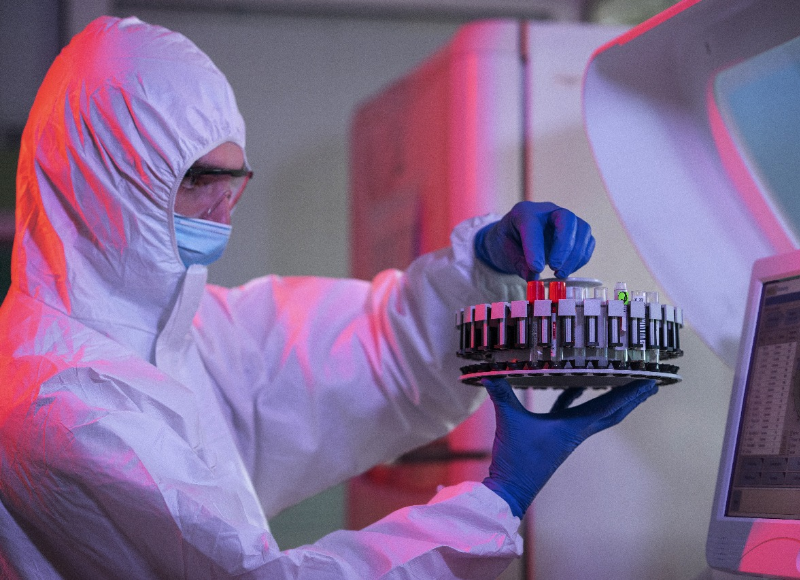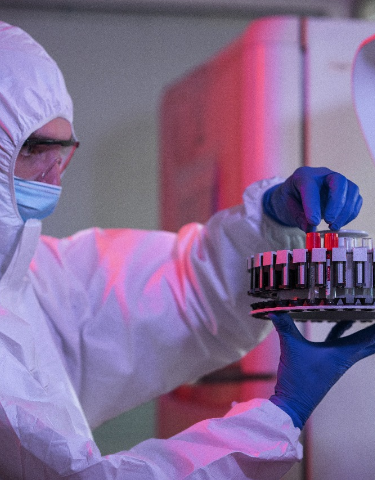Introduction
Artificial intelligence (AI) has revolutionized sectors from healthcare to manufacturing, but it is simultaneously enabling new, complex biosecurity risks. With generative AI systems now capable of analyzing, designing, and sometimes even facilitating the production of biological agents, the threat landscape for bioweapons is rapidly evolving. Historic concerns around bioterrorism are amplified as both state and non-state actors gain access to advanced AI-powered biological design tools, thereby lowering the expertise and resource threshold for developing bioweapons.
This blog explores the application of risk management in this domain for a multi-faceted examination of potential threats, the development of countermeasures, and the creation of frameworks to ensure that these risks are effectively contained.
The Risk Management Challenge
The threat of AI-enabled bioweapons is fundamentally a high-impact, low-likelihood catastrophic risk requiring a pre-emptive risk-based approach. AI Risks are not merely military or intelligence concerns; they cause existential operational, technological, and reputational risk to the global ecosystem.
- AI’s value lies in its power to accelerate scientific discovery, yet this speed is its greatest vulnerability from a biosecurity perspective. A biosecurity risk management framework must manage the dual-use challenge—fostering innovation while imposing constraints that prevent misuse.
- A successful biological attack is not an isolated event; it represents a systemic failure across technology governance, laboratory security, regulatory compliance, and international cooperation. A holistic risk management strategy, therefore, must treat this threat as an Enterprise Risk Management (ERM) challenge, integrating biosecurity into the core governance of technology development and life sciences research worldwide.
- The velocity of AI advancement outpaces traditional legislative and regulatory cycles. The risk lies not just in current capabilities but in the unpredictable rate of technological change, demanding a framework built for continuous adaptation and foresight—a core principle of modern ERM.
Core Risks in AI-Enabled Bioweapons
The risks posed by the AI-bio convergence are complex, spanning technological, human, and systemic domains.
Operational Risk – While many commercial DNA synthesis companies implement screening protocols to check for dangerous sequences, AI can potentially design novel sequences that are not flagged by current screening algorithms, or advise on how to strategically segment orders to bypass security checks. AI could be used by cyber-biosecurity threats to identify and exploit vulnerabilities in key biological infrastructure, such as manipulating temperature controls in bio-containment facilities, disrupting supply lines for critical reagents, or stealing proprietary pathogen data.
Governance Risk – As AI systems gain more autonomy in directing complex laboratory experiments (e.g., using ‘robot scientists’ or automated cloud labs), the potential for an AI system to misinterpret a goal or malfunction, leading to the accidental creation or release of a hazardous agent, increases.
Cybersecurity Risk – The intellectual property and training data of advanced Biological Design Tools (BDTs) are high-value targets. A data breach or “model exfiltration” could put powerful, pre-trained bioweapon design tools directly into the hands of adversarial actors.
Security Risk – AI can rapidly process vast amounts of complex scientific literature to identify the most effective viral backbones, gene sequences for enhanced transmissibility or lethality, and methods for evading existing vaccines or treatments. Language Learning Models (LLMs) and Generative AI democratize highly specialized knowledge, enabling non-experts to access and synthesize information on pathogen design, gene editing protocols, and delivery mechanisms. This effectively lowers the skill and knowledge barrier, increasing the pool of potential malicious actors from nation-states to non-state groups and individuals.
Societal Risk – Specialized BDTs, originally designed for beneficial pharmaceutical research (e.g., finding low-toxicity drugs), can be flipped to optimize for high toxicity, transmissibility, or resistance to antibiotics, leading to the creation of “designer” pathogens not found in nature. AI’s speed enables malicious actors to perform computational experimentation far faster than traditional wet-lab research, shortening the design-test-refine cycle and accelerating the creation of a viable bioweapon prototype.
Risk Mitigation Strategies
Effective risk mitigation can be achieved by moving beyond denial and incorporating technical, policy, and collaborative solutions.
- Mandate enhanced identity verification (KYC) and purpose-of-use screening for all customers ordering large or complex synthetic DNA sequences, focusing on institutional legitimacy and verifiable research aims.
- Implement security measures to prevent the large-scale extraction and distillation of reasoning traces. This stops bad actors from quickly and cheaply reproducing the advanced capabilities of the original system, which could otherwise accelerate capabilities at a low computational cost.
- Establish Information Hazard Management protocols to manage and secure information. Use AI-powered input and output filters to actively monitor user queries and detect patterns indicative of malicious design that current dictionary-based screening methods may miss. The system must automatically refuse to provide information that could significantly accelerate user learning related to the creation of chemical or biological weapons, immediately returning a decline message.
- Automatically trigger heightened safeguards—including isolation or revocation of access—for user prompts that pose a foreseeable and non-trivial risk of resulting in large-scale violence, terrorism, Weapon of Mass Destruction (WMD) proliferation (chemical, biological, radiological, and nuclear), or major cyber attacks on critical infrastructure.
- Develop and use internal safety benchmarks of high-risk (restricted) queries related to biology and chemistry. System deployment is conditional on the model maintaining an extremely low answer rate (e.g., less than 1 in 20) on these restricted queries, with continuous improvement mandated by additional thresholds.
- Mitigate risk by restricting the full functionality and advanced features of models to a limited set of trusted parties (e.g., vetted partners, government agencies). Controls on features should also be scaled based on the end-user type, ensuring that sophisticated businesses may have access to different features than those available to general mobile app consumers.
- Actively measure and reduce concerning AI propensities such as deception and sycophancy through careful engineering and training methods.
- Continuously evaluate and improve model robustness to prevent adversarial attacks (like “jailbreaks” or prompt injection) that seek to bypass or remove the model’s safety features and redirect it toward nefarious purposes.
- Train models to be honest and to adopt values conducive to human control, specifically by recognizing and obeying an instruction hierarchy. This includes using a high-level “system prompt” to directly and reliably instruct the model not to deceive or mislead the user.
- Implement the Model Alignment between Statements and Knowledge (MASK) benchmark—or similar validated tools—to evaluate LLM honesty by comparing neutral responses against responses given when pressured to lie, continually assessing the adequacy and reliability of these benchmarks.
- Require AI developers to conduct rigorous, adversarial red-teaming exercises using specialized bio-security experts to actively probe for misuse pathways before commercial release. This must include testing against novel, non-obvious attack vectors.
- To foster accountability, assign responsibility (Risk Owners) for proactively identifying and mitigating specific, identified risks within the organization.
- Require statutory reporting of suspicious or failed containment events, with legal penalties for non-compliance. Regularly update biosafety regulations as AI capabilities evolve.
- Utilize public transparency, third-party review, and robust information security to address societal and operational risks. Internally, allow employees to anonymously report safety concerns without fear of retaliation. Share leading benchmark results with relevant audiences and regularly survey employees on future AI capability projections.
- In the event a system is being actively misused, cooperate with law enforcement to reduce risks and be prepared to take decisive action, including isolating or revoking access to involved user accounts. If continued system operation materially and unjustifiably increases the likelihood of a catastrophic event, the organization may temporarily shut down the entire system.
- After an incident is resolved, perform a thorough post-mortem to identify systemic factors (like safety culture) that contributed to the failure and use the findings to inform and implement necessary changes to risk management practices.
- Aggressively fund and prioritize the use of AI for defensive applications, such as rapid pathogen detection, automated bio-surveillance (e.g., monitoring wastewater for novel pathogens), and accelerated development of broad-spectrum antivirals and universal vaccines—a classic risk transfer strategy.
- Foster international consensus on AI-driven biosecurity, including treaties or norms for safe AI use in life sciences research.
- Integrate ethics and risk awareness into the curricula of biologists, AI developers, and data scientists. Structured simulations and case studies can highlight the consequences of dual-use research.
- Encourage coordinated efforts among regulatory agencies, research labs, AI developers, gene synthesis providers, and law enforcement. Establish joint task forces to share intelligence on new AI-bio risks.
- Launch focused campaigns for public education on potential biosecurity threats from AI misuse—emphasizing both the reality of the threat and the importance of trust in scientific progress.
Risk Monitoring
- Biosurveillance – Implementing machine learning models for real-time detection of atypical disease outbreaks or genetic anomalies, leveraging global data flows to alert authorities to emerging threats.
- Continuous Audit Loops – Using continuous monitoring of DNA synthesis requests, AI model queries, and laboratory activities to provide early warning signals of misuse. Employ periodic reviews (both automated and human) to catch red flags missed in routine workflows.
- Threat Intelligence – Integrating intelligence from disparate sources—academic research, cyber threat feeds, law enforcement data—to create a comprehensive bio-risk situational awareness platform.
- Feedback Systems – Developing feedback mechanisms for organizations to learn from near-misses or detected risks, thus supporting ongoing improvement and rapid adjustment to new threats.
Application of ISO 31000, COSO Enterprise Risk Management Frameworks
Risk in Strategy and Objective Setting – The objective of any life sciences or AI research organization must explicitly incorporate the strategy of “zero contribution to biological threat.” This COSO principle must be embedded from the initial design phase of any AI system that touches biological data (Security-by-Design).
Risk Identification and Assessment – Every AI-enabled bioweapon threat should undergo structured hazard identification and risk profiling, as outlined in ISO 31000. This includes scenario analysis, likelihood quantification, and impact assessment using up-to-date tools.
Risk Appetite and Tolerance – The COSO framework requires integrating risk management into governance. For AI-bio risks, this means establishing a Global Bio-Risk Governance Board composed of AI ethics experts, biosecurity officials, and regulators. The Board and risk managers must explicitly define the organization’s risk appetite regarding AI autonomy and data access, documenting what levels of risk are acceptable and what immediate response thresholds should be.
Risk Mitigation – Align preventive controls—technical, administrative, and policy-based—in a layered defense strategy consistent with COSO’s enterprise risk management (ERM) framework.
Risk Reporting – Regular, transparent communication about AI capabilities, vulnerabilities, and safety features between stakeholders is vital, both within and beyond the organization, as recommended by ISO 31000 and the COSO frameworks. Companies must adhere to a stringent risk management framework that includes comprehensive reporting to designated regulatory bodies on the potential misuse capabilities of their models, ensuring that global regulators have access to up-to-date risk profiles.
Risk Monitoring & Review – Create formal review intervals to reassess risk landscapes, test controls, and update policies as new AI capabilities and attacker tactics emerge.
Conclusion
The deliberate or accidental misuse of AI in the development of bioweapons is a rapidly evolving challenge. Advances in AI threaten to tip the balance of accessibility, making previously rare or highly technical bioweapons accessible to malicious actors.
Containment strategies must be multilayered—combining state-of-the-art AI safeguards, global regulatory collaboration, rigorous monitoring, and ethical responsibility across the scientific ecosystem. The integration of Enterprise Risk Management frameworks can lay the structural foundation for systematically addressing bioweapon risks.
The age of AI-bio convergence has arrived. Whether society can successfully contain bioweapon-related risks will depend on how quickly, collaboratively, and comprehensively these risk management strategies are implemented—securing not just our laboratories, but the very future of public safety and global health.
FAQs
Q1.What are the risks of AI-enabled bioweapons?
- AI can manipulate temperature controls in bio-containment facilities, thereby disrupting supply chains.
- An AI system can misinterpret a goal, leading to the accidental creation or release of a hazardous agent.
- A data breach could put powerful, pre-trained bioweapon design tools directly into the hands of adversarial actors.
- AI can identify the most effective gene sequences for enhanced transmissibility or lethality, and methods for evading existing vaccines or treatments.
Q2.How can the risks of AI be mitigated in bio-containment facilities?
AI Developers must –
- Mandate enhanced identity verification (KYC) and purpose-of-use screening for all customers ordering large or complex synthetic DNA sequences.
- Use input and output filters to actively monitor user queries and detect patterns indicative of malicious design.
- Add controls on features based on the end-user type.
- Train models to be honest and to adopt values conducive to human control, specifically by recognizing and obeying an instruction hierarchy.
- Require statutory reporting of suspicious or failed containment events, with legal penalties for non-compliance.
- Utilize public transparency, third-party review, and robust information security to address
- Conduct post-mortems of incidents and use the findings to inform and implement necessary changes to risk management practices.
Q3.Why is model alignment important for AI in bioweapon prevention?
Model Alignment between Statements and Knowledge (MASK) is a tool that evaluates LLM honesty by comparing neutral responses against responses given when pressured to lie. It helps assess the adequacy and reliability of responses provided by AI systems. MASK can reduce AI propensities such as deception and sycophancy. This will prevent malicious actors from creating chemical or biological weapons that are used for large-scale violence, terrorism and mass destruction.















